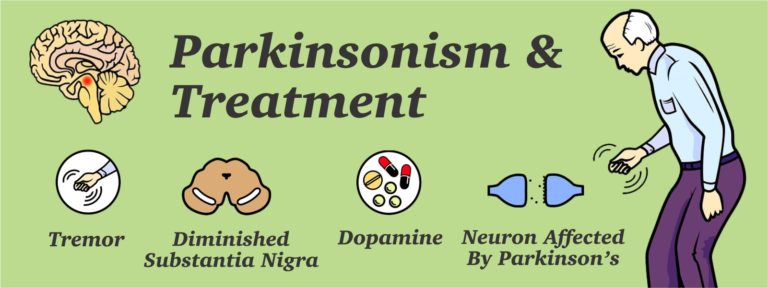Parkinsonism is a chronic, progressive, motor disorder characterized by rigidity, tremors and bradykinesia.
Other symptoms include excessive salivation, abnormalities of posture and hait, seborrhea and mood change. It was described by James Parkinson in 1817 and is therefore named after him. The incidence is about 1% population of population above 65 years of age. It is usually idiopathic in origin but can also be drug induced.
In
idiopathic parkinsonism, there is degeneration of nigrostriatal neurons in the basal ganglia resulting in dopamine deficiency. The balance between dopaminergic neurons and excitatory cholinergic neurons is distributed. Parkinson’s disease itself refers to dysfunction and cell death of the portion of the brain that produces dopamine.
Dopamine is a neurotransmitter — a chemical that transmits signals between brain and nerve cells. It is partially responsible for making controlled movements in the body. Parkinson’s disease itself refers to dysfunction and cell death of the portion of the brain that produces dopamine. Dopamine is a neurotransmitter — a chemical that transmits signals between brain and nerve cells. It is partially responsible for making controlled movements in the body.
COMMON SYMPTOMS:
Difficulty showing facial expressions, muscle stiffness, slowed, affected movements, speech changes, tremor, especially of one hand, dementia, issues with the
autonomic nervous system, such as problems with controlled movements or spasms, early problems with balance, rapid onset and progression of symptoms.
CAUSES OF PARKINSONISM
Parkinsonism can be caused by Parkinson’s disease itself as well as another underlying condition: Corticobasal degeneration, Dementia with Lewy bodies Multiple system atrophy and Progressive supranuclear palsy.
DIFFERENT FORMS OF PARKINSONISM
Idiopathic
- Parkinson’s. Idiopathic means the cause is unknown.
- tremor, rigidity and slowness of movement.
Vascular
Drug-induced
DIAGNOSE OF PARKINSONISM
Diagnosis remains clinical and is based on motor manifestations. Brain MRI or CT and molecular imaging (ie of the dopamine transporter in the striatum) of the striatum may be performed to support clinical evaluation. The clinical features of PD include both the motor symptoms (described above), as well as non-motor issues. These non-motor symptoms include
neuropsychiatric symptoms including mood disturbances and cognitive changes; autonomic dysfunction, pain and sleep issues.
Doctors can perform a test that tracks the movement of dopamine in the brain. This is known as the DaT-SPECT test. The test uses radioactive markers designed to track dopamine in the brain. This allows a doctor to watch the release of dopamine in a person’s brain and identify the areas of the brain that do or do not receive it.
TREATMENTS
Levodopa has remained the cornerstone of PD treatment for more than 50 years. However, after a few years of treatment and mainly due to the progression of the disease, the benefit of levodopa shortens and motor complications appear in many patients.
This had led to the introduction of many other medications including inhibitors of catechol-O-methyltransferase (COMT), monoamine oxidase type B (MAO-B) inhibitors and dopamine agonists. Enzyme blockers act by either extending levodopa or dopamine half-life while dopamine agonists mimic the action of dopamine on brain dopamine receptors.
More recently, surgical and infusion therapies have become available to improve management in selective patients with motor complications. Surgery includes the use of deep brain stimulation of the subthalamic nucleus and globus pallidus internus.
The use of drug infusions is based on the possibility to deliver continuously either levodopa or apomorphine (a dopamine agonist with high affinity to dopamine receptors), mimicking the natural tonic receptor stimulation in the basal ganglia. As a result, treatments for Parkinsonism depend upon the “plus” disease that a person has.
For example, if a person has corticobasal degeneration and related muscle spasms, a doctor may prescribe antidepressants and botulinum toxin A (BOTOX) injections.
Treatments for Parkinsonism usually aim to help reduce a person’s symptoms whenever possible to help them maintain independence. Doctors often recommend physical and occupational therapy because they can help a person keep their muscles strong and improve balance.




